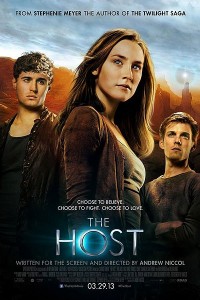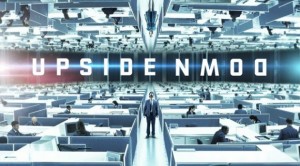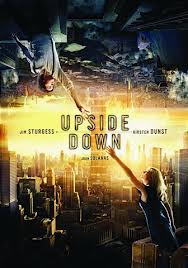The Host
Posted on March 28, 2013 at 6:00 pm
C-| Lowest Recommended Age: | Middle School |
| MPAA Rating: | PG-13 for some sensuality and violence |
| Profanity: | Some mild language |
| Alcohol/ Drugs: | Drinking |
| Violence/ Scariness: | Extended sci-fi peril and violence, characters injured and killed, attempted suicide, character shot with gun, some disturbing images |
| Diversity Issues: | A theme of the movie |
| Date Released to Theaters: | March 29, 2013 |
| Amazon.com ASIN: | B0090SI4OC |
 The author of the Twilight series was showing signs of running out of ideas around the middle of the second volume, and this latest story shows more evidence of the pressure of producing a new series than anything approaching inspiration. Howlers that can slide by in print are impossible to ignore in a thuddingly dumb story of an alien takeover and the girl who is able to hold onto her own consciousness as the “host” of glowing millipede from outer space.
The author of the Twilight series was showing signs of running out of ideas around the middle of the second volume, and this latest story shows more evidence of the pressure of producing a new series than anything approaching inspiration. Howlers that can slide by in print are impossible to ignore in a thuddingly dumb story of an alien takeover and the girl who is able to hold onto her own consciousness as the “host” of glowing millipede from outer space.
Problem #1: If you’re going to make a movie about aliens taking over human bodies, the indicator of possession should not be glowing blue eyes that eliminate a critical element of the actors’ ability to communicate.
Melanie Stryder (Saoirse Ronan) is one of the few remaining humans who have not been overtaken by alien invaders who have inhabited almost every person on earth and eliminated suffering, illness, and conflict — also passion, independence, innovation, and any notion of the individual. Everything is smooth and civil and orderly. It is like the whole planet moves to Muzak. But they have excellent healthcare.
Melanie is captured by the aliens, led by Seeker, who heal her injuries and implant one of their aliens inside her. But instead of taking over her consciousness, the invader, known as Wanderer, exists side by side, leading to a series of back-and-forth conversations intended to be touching but are more often mundane. She’s like a bad ventriloquist with two invisible dummies. It is clunky and dull when she talks to herself but not much better when the characters talk to one another. “What’s it like in there?” a character asks Melanie/Wanda. “It’s crowded.” “Kiss me like you want to get slapped.”
Ronan is a superb actress, but even she cannot make real the idea of these two equally drippy characters as distinctive individuals, especially after she hides out with a secret rebel group led by Jeb (William Hurt), and in “Twilight” love triangle fashion becomes involved with two different cute guys, one who loves Melanie and one who loves the Wanderer, now known as Wanda. “If you could hold me — me — in your hand, you’d be disgusted,” Wanda explains to the guy who wants to kiss her. When he finally does see what the alien looks like and tries to gaze tenderly at a glowing bug is just silly.
And then things really go nuts as the Seeker (Diane Kruger) goes after the human rebels, insisting, “I am not weak. I am in control.” Kruger is more believable as an alien than she usually is as a human, at least until a ridiculous twist near the end. Melanie had two voices in her head. I only had one, but it was clearly telling me that this movie is a mess.
This rebel group seems weirdly retro, with almost no women, and a social structure that resembles the 18th century.
Parents should know that this film includes extended sci-fi style peril and violence with some disturbing images, a car crash, aliens, possession, characters injured, some teen kissing and sensual embraces.
Family discussion: Why could Melanie and Wanda exist together? How do Ian and Jared see her differently? Why are the aliens able to achieve societal benefits humans have failed to? How does she earn the trust of the humans? What do you think will happen next?
If you like this, try: “Invasion of the Body Snatchers” and “I Am Number Four” and the book by Stephenie Meyer




